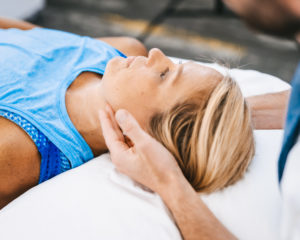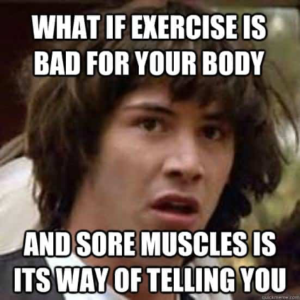How Physical Therapy Can Benefit Patients with Anxiety & Depression
Physical therapy can have a monumental impact on a person’s life. Often these benefits on in the physical realm, such as strength, power, endurance, hypertrophy, balance, mobility, and functional capacity.
While many cognitive and emotional benefits have been recognized as well, they often viewed as a means to obtain the previously mentioned physical improvements – the ultimate goals. We know building a therapeutic alliance and trust can assist with education – such as improving a patient’s understanding of pain – but achieving functional goals are the primary focus. Through education, physical therapists may attempt to influence a patient’s lifestyle habits such as their diet, physical activity levels, and sleep hygiene. Once again, ultimately, these strategies are aimed to improve the aforementioned physical benefits.

Occasionally as physical therapists, we sell ourselves short and fail to understand the breadth of impact we can have. I am referring to the psychological benefits that can increase the value of care we provide. Understanding the breadth of therapeutic benefits we provide is more important than ever. The COVID-19 pandemic has greatly impacted everyone in some manner.
In physical therapy, we have responded to the need for social distancing by increasing access to telehealth services. Yet, some clinicians may be discouraged by the lack of physical contact and the ability to perform manual therapy when delivering telehealth services. I ask that you do not discount the impact exercise and your words can have on patients. Many of them need us now more than ever and the methods we choose to deliver care can be a difference-maker as patients navigate through this pandemic.

Social distancing and financial stressors resulting from the pandemic has led to a widespread increase in anxiety and depression. The CDC has compiled resources for people to help with mental health. We as physical therapists are in a position to help as well. Physical Therapists have been identified as professionals who can effectively deliver exercise interventions to help patients suffering from anxiety and depression. 1
How PT and exercise can help patients with anxiety and depression
While this post will focus on the manners in which we facilitate psychological benefits for our patients, it is important to understand our scope of practice. We are not clinical psychologists or psychiatrists and must avoid wandering outside of our training and expertise. If you suspect a patient may have clinical depression or other psychiatric disorders, determine whether they are receiving appropriate care, and make necessary referrals.
There are many communication strategies we can use that are born out of psychology (e.g. motivational interviewing) just as there are other techniques that have been more extensively studied and practiced in other professions (e.g. exercise and massage). What I am advocating for is the use of different techniques and principles that are within our scope but often negated as they are not “mainstream.” While we may not structure a plan of care around a patient’s anxiety or depression or attempt to be the sole health professional leading the case, we certainly can help with the treatment of each.
I understand we often provide degrees of talk therapy and I am not stating that is outside our scope, but it can be easy to fall into conversations that have the potential to spiral out of control and lead to more harm than good. What I want to focus on is obtaining potential secondary benefits of reducing symptoms of anxiety and depression through our most powerful and refined intervention: exercise.
The many benefits of exercise
There are several ways in which exercise can yield beneficial effects for reducing depression and anxiety. Both depression and anxiety can have a substantial negative impact on a patient’s quality of life (QoL). QoL can be defined as “a state of well-being that is a composite of two components:2
- The ability to perform everyday activities that reflect physical, psychological and social well-being
- Patient satisfaction with levels of functioning and the control of disease and/or treatment-related symptoms.
Many studies have demonstrated that regular exercise can substantially improve QoL in patients suffering from serious long-term conditions, such as depression and anxiety. How exactly does exercise help? Let’s start with anxiety.
Exercise for anxiety
One of the primary methods of reducing anxiety is by using physical activity to reduce anxiety sensitivity. Many patients suffering from anxiety report the bodily symptoms they experience are the most debilitating and lead to the avoidance of exercise. Any stimuli that create a similar response to an anxiety attack (e.g. increased HR) are interpreted in a catastrophic way and avoided.
To reduce anxiety sensitivity, clinicians can reliably produce these similar physiological responses through exercise in conjunction with careful and thorough information to alleviate the concerns. The patient will begin to dissociate the experience of the physical symptoms and negative, anxious feelings.
Essentially, prescribed personalized exercises can help patients interpret bodily symptoms as normal signs of stress and not as indicators that a physical catastrophe will ensue. 3, 4
Exercise for depression
With respect to depression, exercise decreases and replaces passivity to create a sense of accomplishment and pleasure in patients 2, 4 Feelings of achievement and mastery through exercise can help to enhance positive self-beliefs and buffer from negative self-perception worries. 3 Furthermore, a patient is able to develop a social connection through physical activity to improve patient affect 2. This is not a one size fits all social connection. For some patients, the connection may be with the clinician, for some it may be with friends or family, and others may connect with fellow patients who can relate to their current experiences.
Along with external support and a sense of achievement, exercise-based interventions have been consistently demonstrated as having an antidepressant effect in people with clinical depression, with some studies reporting a treatment efficacy comparable to antidepressant medications or psychotherapy. 3
How much exercise is needed to help with anxiety and depression?
Ok, so you agree that exercise can be beneficial, but the million-dollar question remains “how much and what type?” Unfortunately, the dosage question has not been extensively studied and little consensus remains. The prescription recommendations are often derived from general exercise prescription guidelines intended to improve physical fitness and cardiometabolic health. One set of guidelines currently in use are the NICE guidelines.
For depression, they recommend three times per week (45 minutes to 1 hour each session) for 10-14 weeks. Bear in mind, these recommendations are for mild to moderate depression. The total duration that is necessary to see significant anti-depressive and anti-anxiety effects fall in the 10-14-week range.
The mode of exercise is largely grouped into two categories: aerobic training and resistance training. Aerobic training (stationary bike, increase treadmill walking, etc) is typically the primary mode of choice for general psychological stress, depression, and anxiety, however, one study compared acute bouts of aerobic and resistance exercise and demonstrated equivocal improvements in reducing anxiety sensitivity. 3 In general, resistance training has a small to moderate impact on reducing anxiety symptoms in clinical and non-clinical populations. 3 It also can improve distress tolerance and intolerance of uncertainty. 3
How much intensity is needed?
How about intensity? During the initial treatment stages, preferred – rather than prescribed – intensity can be used to improve psychological, physiological, and social outcomes and exercise participation rates. 2 When using an affect-based prescription, the patient is shown a simple rating scale (e.g., one ranging from +5: “I feel very good” to −5: “I feel very bad”) and is instructed to self-regulate his or her exercise intensity and duration to maintain a rating of +3 or higher. Some evidence demonstrates that for individuals with depression, the affective responses to exercises may predict the overall treatment response. 1
Another way to measure overall intensity, in conjunction with duration and frequency, is to achieve a weekly energy expenditure of > 17.5 kcal/kg. 4 The recommendation is to achieve those energy expenditure thresholds through 3 to 5 sessions per week. As a patient moves into the middle stages of treatment and tolerance to activity improves, the focus shifts to mediating inflammatory pathways.
These anti-inflammatory benefits are obtained when exercise intensity is moderate (using traditional measures such as HR and % of 1RM). 1, 3 The later stages are focused on self-efficacy and tasks specific activities, which may necessitate the progression to vigorous exercise intensity as well. As intensity progresses, be aware of the tolerance to high intensity and the potential recovery period needed. Even “soreness” can be interpreted as pain and an exacerbation of symptoms may lead to a reversal of improvements made.

Harness the power of exercise
Exercise is an extremely powerful tool at our disposal. Any patient that walks through our doors – or appears on our computer screen through telehealth – can benefit from exercise. We often discuss the need for appropriate intensity of exercise to induce the desired changes in strength, endurance, power, and muscle hypertrophy. It is important to consider our exercise dosage as it applies to patients suffering from depression, anxiety, or both. The ability to fine-tune exercises to specific patient-needs allows us to provide incredible value.
Regardless of the intervention we provide, it is important to remember that we are therapists. We don’t only provide physical benefits or treat pain. We don’t have to depend on a single type of treatment – such as manual therapy – to provide value. The interventions we provide can dramatically influence a patient’s life. Don’t discredit the help we can provide people in this time of need.
References
- Belvederi Murri, M., et al., Physical Exercise in Major Depression: Reducing the Mortality Gap While Improving Clinical Outcomes. Front Psychiatry, 2018. 9: p. 762.
- Blake, H., Physical activity and exercise in the treatment of depression. Front Psychiatry, 2012. 3: p. 106.
- Kandola, A., et al., Moving to Beat Anxiety: Epidemiology and Therapeutic Issues with Physical Activity for Anxiety. Curr Psychiatry Rep, 2018. 20(8): p. 63.
- Martinsen, E.W., Physical activity in the prevention and treatment of anxiety and depression. Nord J Psychiatry, 2008. 62 Suppl 47: p. 25-9.
About The Author
